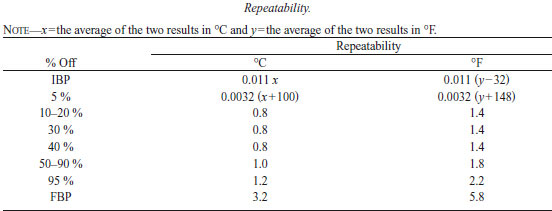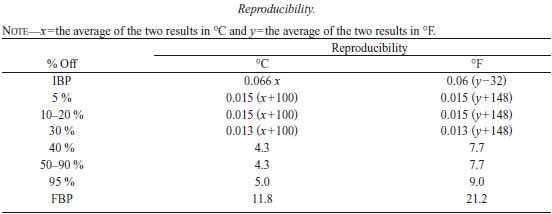(Equivalent Test Methods: IP 321, ISO 3924, and JIS K 2254)
EXPLANATION
The determination of the boiling range distribution of petroleum fractions by gas chromatography is a rapid analytical tool, which may be used to replace conventional distillation methods for control of refining operations and specification testing. Data derived by this test method are essentially equivalent to that obtained by TBP distillation (Test Method D2892). They are not equivalent to results from low efficiency distillations such as those obtained with Test Methods D86 or D1160. This test method is applicable to petroleum products and fractions with a final boiling point of 538° C (1000° F) or lower at atmospheric pressure as measured by this test method. This test method is not designed for use with gasoline samples or gasoline components. These samples must be analyzed by Test Method D3710. This test method is limited to samples having a boiling range greater than 55° C (100° F), and having a vapor pressure sufficiently low to permit sampling at ambient temperature.
A correlation of 17 % oil volatility by GC-SD methods (Test Methods D2887 or D5480) has been found equivalent to 21.5 % volatility by Noack method.
DEFINITIONS
Initial Boiling Point - the point at which a cumulative area count equal to 0.5 % of the total area under the chromatogram is obtained.
Final Boiling Point - the point at which a cumulative area count equal to 99.5 % of the total area under the chromatogram is obtained.
TEST SUMMARY
The boiling range distribution determination by distillation is simulated by the use of gas chromatography. A nonpolar packed or open tubular (capillary) gas chromatographic column is used to elute the hydrocarbon components of the sample in order of increasing boiling point. The column temperature is raised at a reproducible linear rate and the area under the chromatogram is recorded throughout the analysis. Boiling points the assigned to the time axis from a calibration curve obtained under the same chromatographic conditions by analyzing a known mixture of hydrocarbons covering the boiling range expected in the sample. From these data, the boiling range distribution can be obtained.
TEST PRECISION

